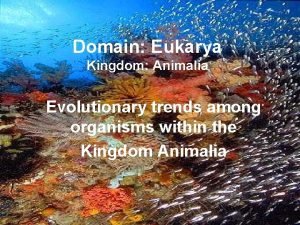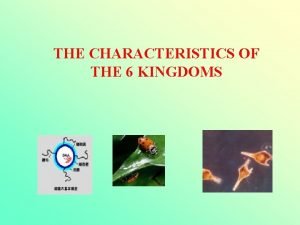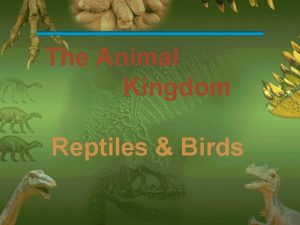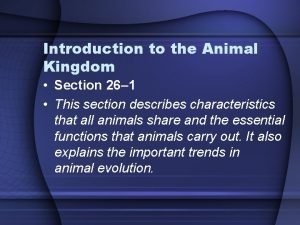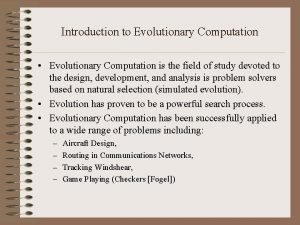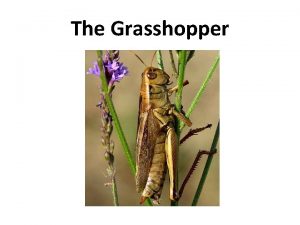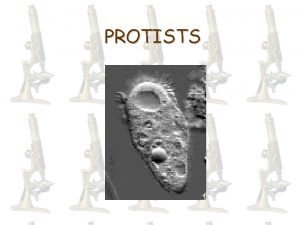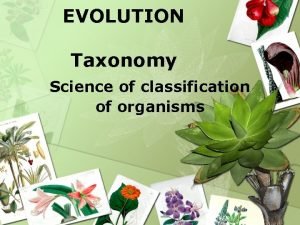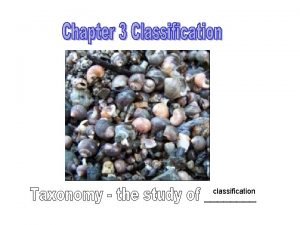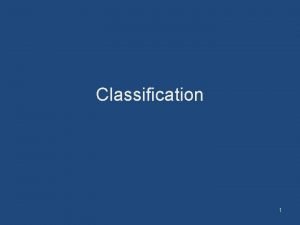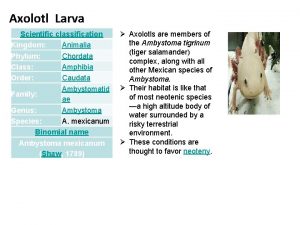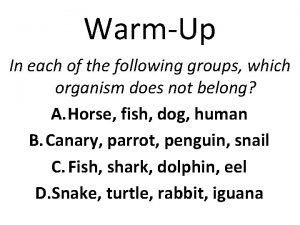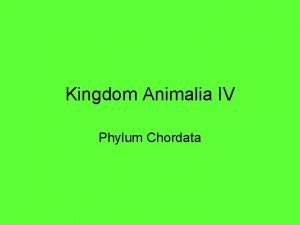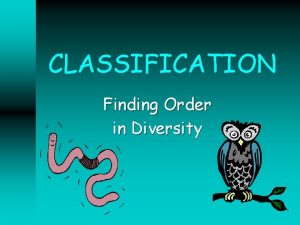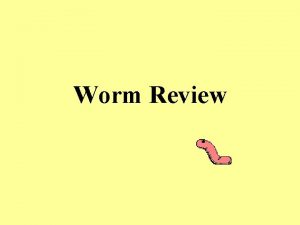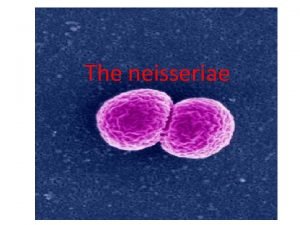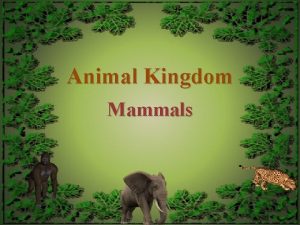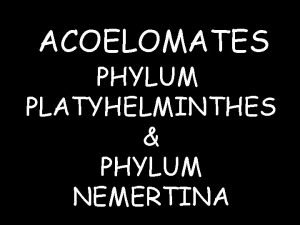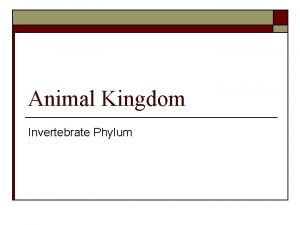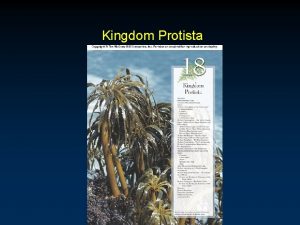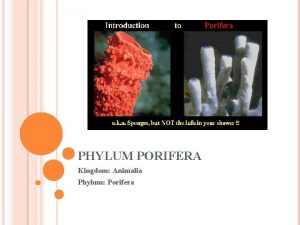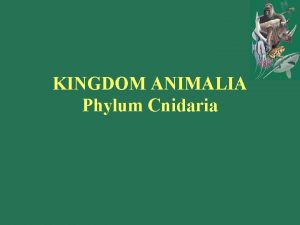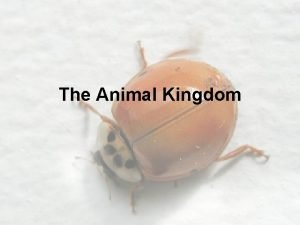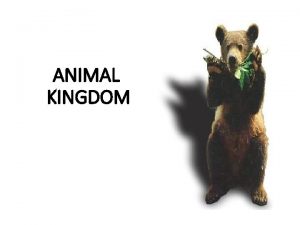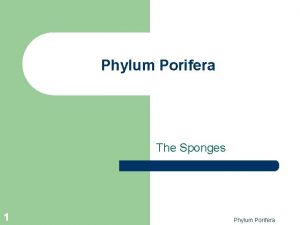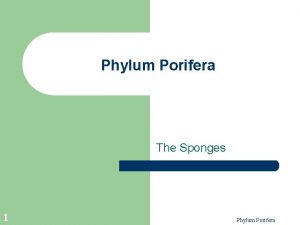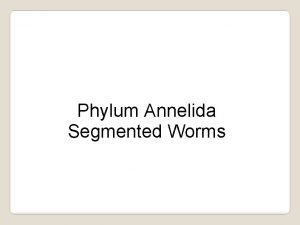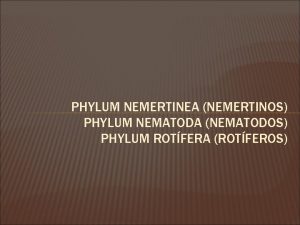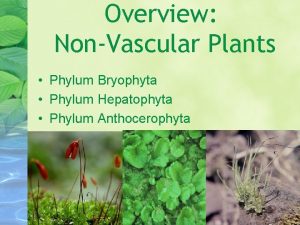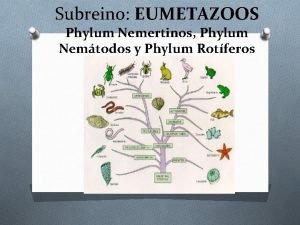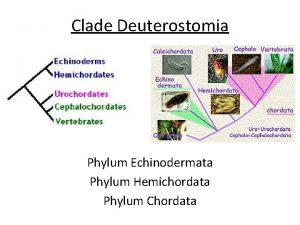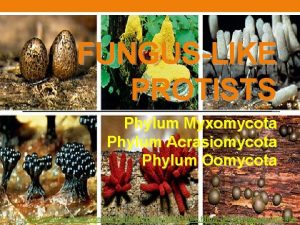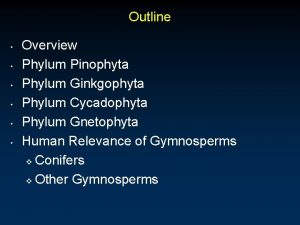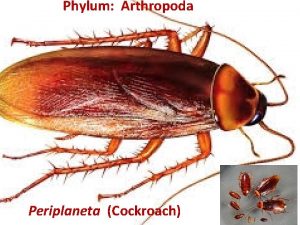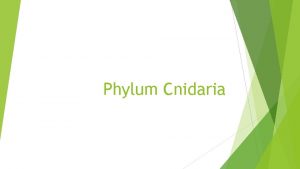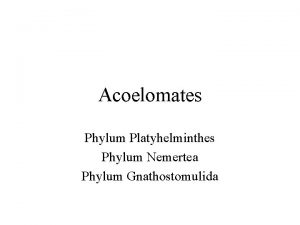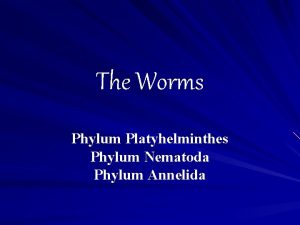Introduction to the Animal Kingdom Examples Phylum Evolutionary




























- Slides: 28

Introduction to the Animal Kingdom Examples Phylum Evolutionary Milestone Porifera sponges multicellularity Cnidaria jellyfish, hydra, coral tissues Platyhelminthes flatworms bilateral symmetry Nematoda roundworms pseudocoelom Mollusca clams, squids, snails coelom Annelida earthworms, leeches segmentation Arthropoda insects, spiders, crustaceans jointed appendages Echinodermata starfish deuterostomes Chordata vertebrates notochord

Invertebrates vs Chordates l Invertebrates – – – l Includes 95% of animals Includes 33 Phyla No vertebral column/backbone Chordates – – – Includes 5% of animals Includes Phylum Chordata 4 Characteristics (at some point during life) l l Nerve cord and/or Vertebral Column Notchord Tail ext. beyond the anus Pharyngeal pouches

Symmetry l Body Symmetry – l Asymmetry – l no pattern (corals, sponges) Radial Symmetry – l the body plan of an animal, how its parts are arranged shaped like a wheel (starfish, hydra, jellyfish) Bilateral Symmetry – has a right and left side (humans, insects, cats, etc)

Germ Layers l 1. 2. 3. The blastula develops 3 distinct layers, which become layers in the organism Ectoderm - outer layer of skin, nervous tissue, sense organs Endoderm - lining of digestive tract, digestive and respiratory system Mesoderm - skeleton, muscles, excretory system

Body Cavity l Coelom – l Pseudocoelom – l Fluid filled cavity in the mesoderm that is lined with mesodermal tissues Partially filled with mesoderm Acoelomate – Have no bodycavity

Cephalization l Cephalization – an anterior concentration of sense organs (to have a head)

Cephalization Cont. l l Anterior - toward the head Posterior - toward the tail Dorsal - back side Ventral - belly side

Types of Feeders l Filter Feeders – l Detritivores – l Eat plants Omnivore – l Eat other animals Herbivores – l Feed on decaying plants/animals Carnivores – l Strain food from water Eats both animals and plants Nutritional Symbionts – Depend on another species

Digestion l Intracellular – – l Use cells to digest food Used by less complex animals Extracullular – – Use a digestive system to digest food Used by more complex animals

Respiration l l All animals exchange oxygen with carbon dioxide Types of Respiration – – – Skin Respiration – oxygen/carbon dioxide diffuse across thin membranes Gills Lungs

Circulation l l Diffusion Open – l Blood is only partially contained in blood vessels Closed – Blood is contained within blood vessels

Response/Nervous l Neurons – l Stimulus – l Something in the environment that causes neurons to react Sensory Neurons – l Nerve cells Specialized neurons that vary from animal to animal Response – A reaction to a stimulus

Types of Nervous Systems l Nerve Nets, Nerve Cords & Ganglia – l Heads – l Simple nervous system Cephalized animals have grouped neurons that form cerebral ganglia in the head region Brains – Cerebral ganglia are further organized into a brain

Excretion l l l Diffusion Flame cells Solid waste through anus Fluid waste through nephridia Malpighian tubles

Reproduction l Asexual – – – l 1 parent Benefit: Can reproduce quickly Drawback: Less genetic diversity Sexual – – – 2 parents Benefit: Increased genetic diversity Drawbacks: Both genders must be present, takes more time

Movement l Sessile Cilia l Skeletal – For Support l – – – l Hydrostatic: Fluid Filled Cavity Exoskeleton: External Skeleton Endoskeleton: Internal Skeleton Muscles – For Movement

Types

Invertebrates Nematoda

PHYLUM NEMATODA l l ROUNDWORMS 24, 773 KNOWN SPECIES NON-SEGMENTED WORM WITH PSEUDOCOELOM FIRST ORGANISM WITH MOUTH AND ANUS

Symmetry l Bilateral

FEEDING l Most common groups are bacterial-feeding, fungal-feeder, plant parasite, predators, omnivore or detritivore

CIRCULATION l DIFFUSION into and out of cells- (higher concentration to lower)

EXCRETION l Anus (digestive wastes) or pores (Ammonia waste out pores)

RESPONSE • Central nervous system to detect and react to environment. • Primitive brain called a nerve ring • ganglia

MOVEMENT l l Muscle cells (length of bodies) contract to move Hydrostatic skeleton

REPRODUCTION Sexual Reproduction (most have separate male & female) – Internal Fertilization – A few hermaphrodites –

RESPIRATION l DIFFUSION through skin (oxygen for burning food and carbon dioxide waste)

Roundworm Examples l l Trichinosis-Causing Worms – Cause trichinosis – Live in intestines of host – Invade hosts organs and muscle tissue Filarial Worms – Line in blood/lymph vessels – Transmitted through biting insects – Cause elephantitis Ascarid Worms – Cause malnutrition, spread by eating vegetables Hookworms – Live in soil and hook onto feet of host, burrow into skin and enter bloodstream – Suck hosts blood in lungs and intestines causing weakness
 Coelom
Coelom Old kingdom middle kingdom new kingdom
Old kingdom middle kingdom new kingdom Old kingdom middle kingdom new kingdom
Old kingdom middle kingdom new kingdom Old kingdom middle kingdom new kingdom
Old kingdom middle kingdom new kingdom Capital of egypt during the old kingdom
Capital of egypt during the old kingdom Wolf classification
Wolf classification Reptiles order
Reptiles order Animal kingdom phylogenetic tree
Animal kingdom phylogenetic tree 26-1 introduction to the animal kingdom
26-1 introduction to the animal kingdom Introduction to evolutionary computing
Introduction to evolutionary computing Phylum subphylum class order
Phylum subphylum class order Kingdom family genus species
Kingdom family genus species Kingdom phylum class
Kingdom phylum class Domain kingdom phylum
Domain kingdom phylum Family order genus species
Family order genus species What are the 8 levels of classification
What are the 8 levels of classification Horse classification
Horse classification Kingdom phylum class order of humans
Kingdom phylum class order of humans Domain kingdom phylum
Domain kingdom phylum Domain kingdom phylum mnemonic
Domain kingdom phylum mnemonic Domain kingdom phylum class
Domain kingdom phylum class Kingdom of axolotl
Kingdom of axolotl Aves kingdom
Aves kingdom Classification of humans
Classification of humans King phillip came over for good soup
King phillip came over for good soup What are chordates
What are chordates Phylum order
Phylum order Earthworms belong to the kingdom
Earthworms belong to the kingdom Neisseria gonorrhoeae kingdom
Neisseria gonorrhoeae kingdom
